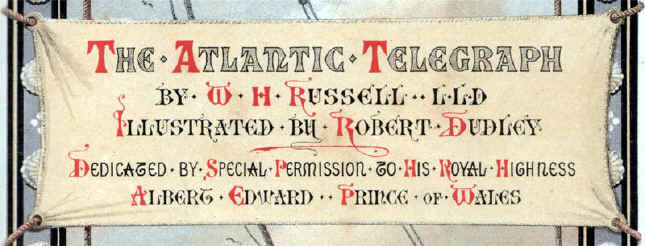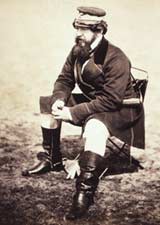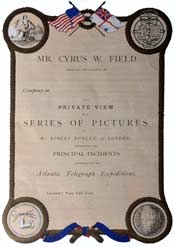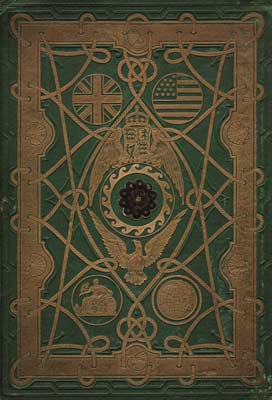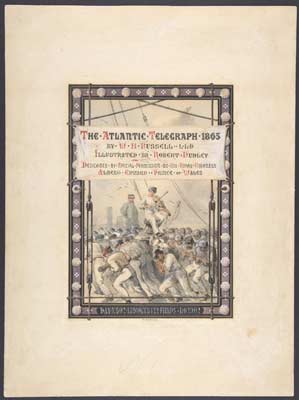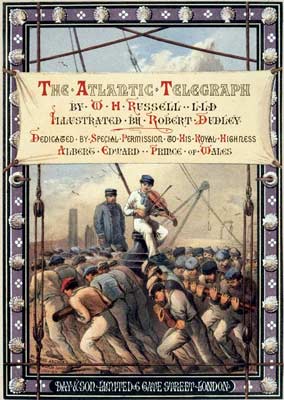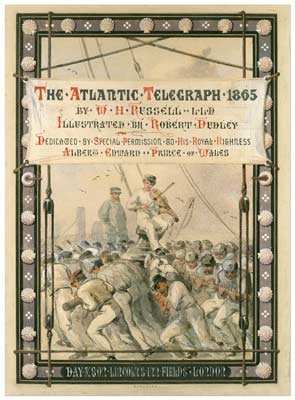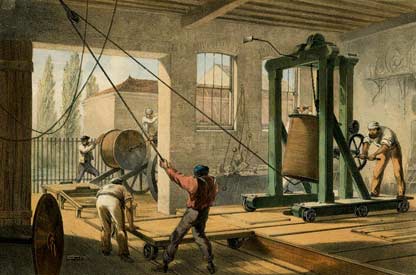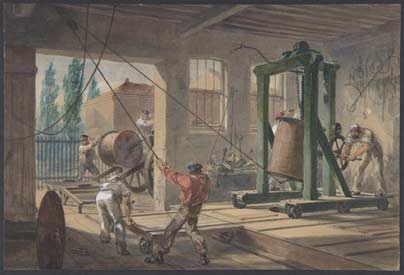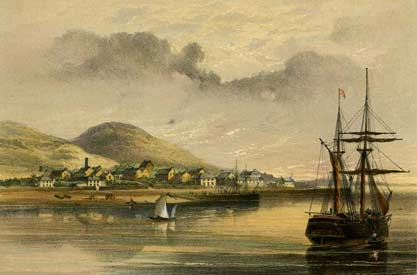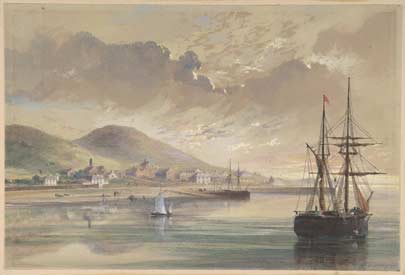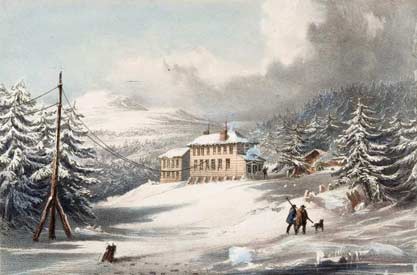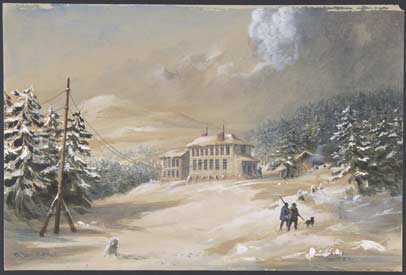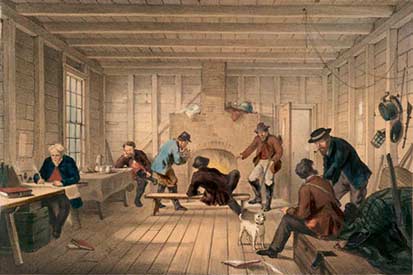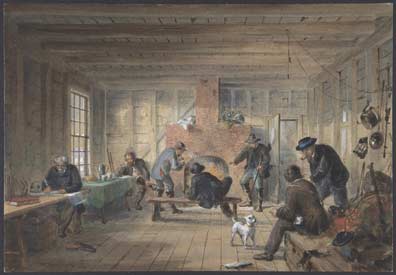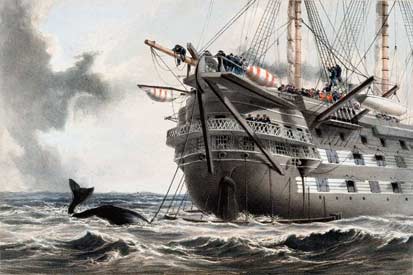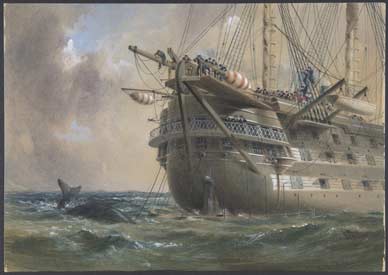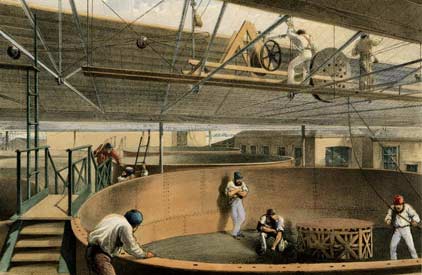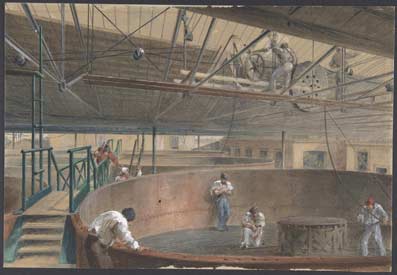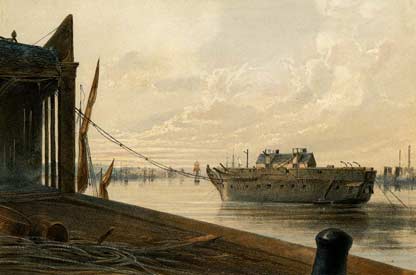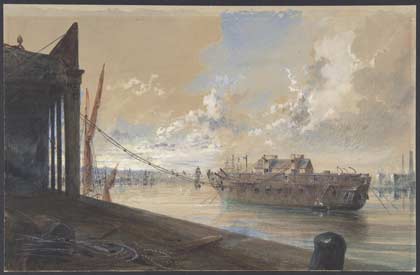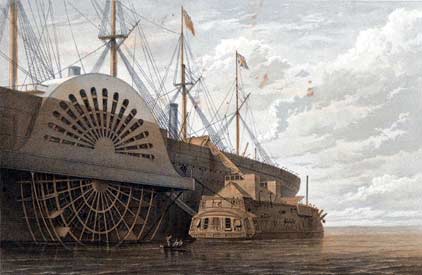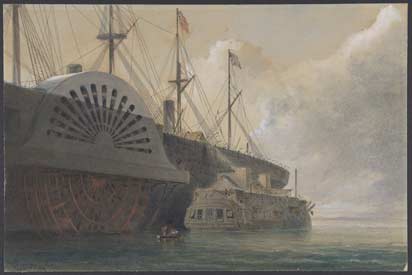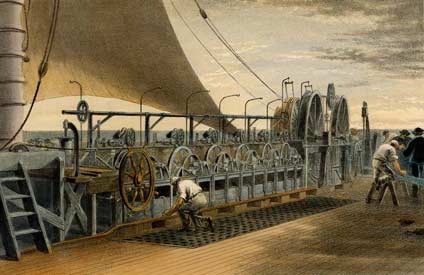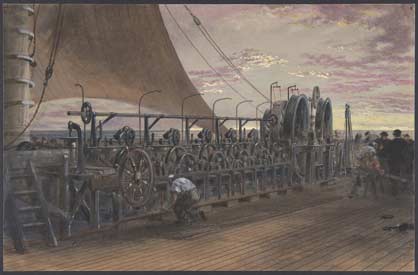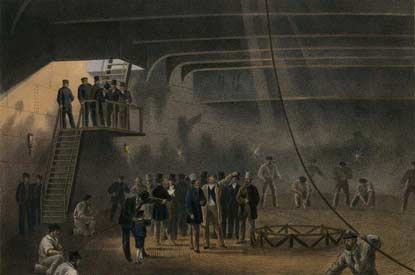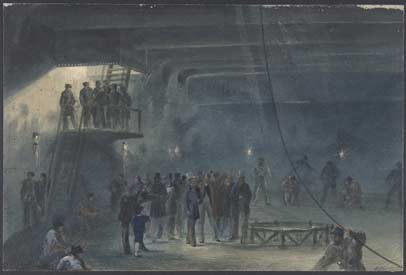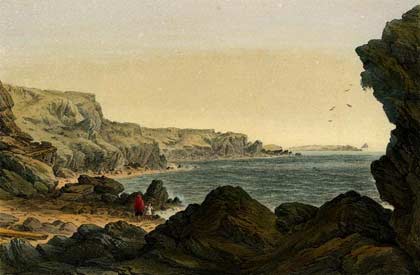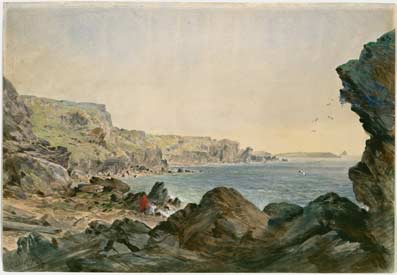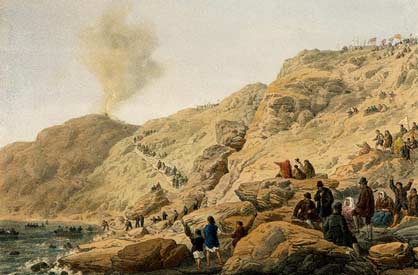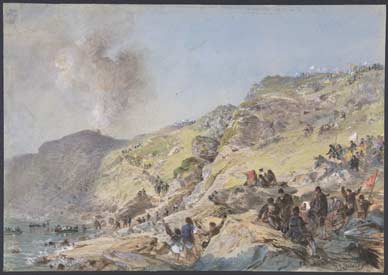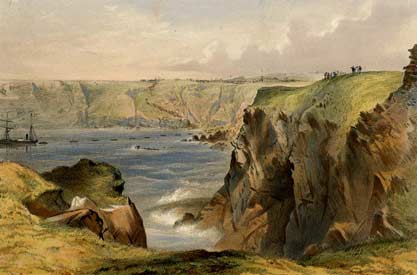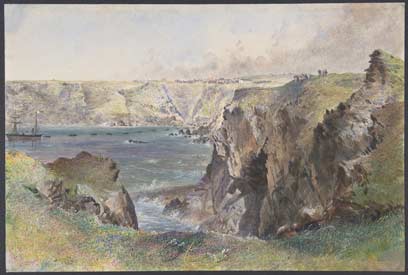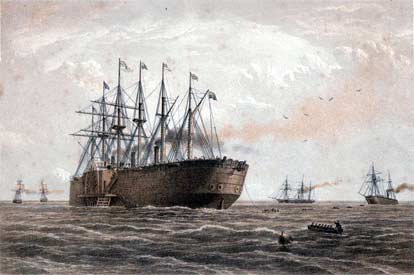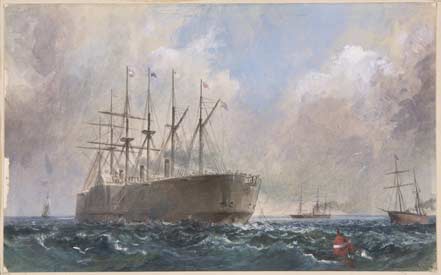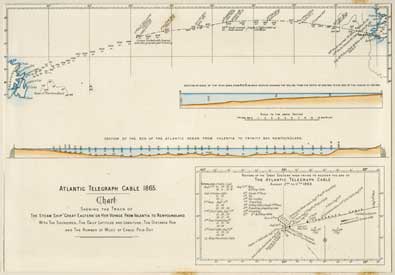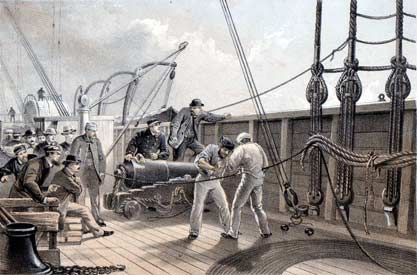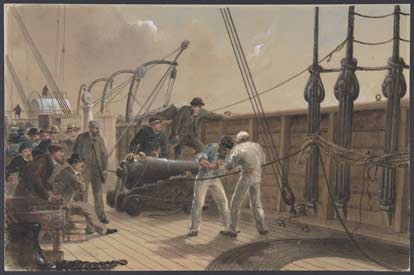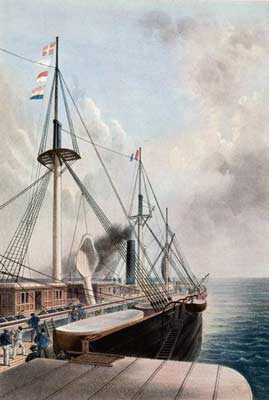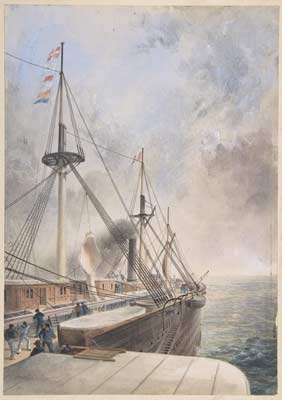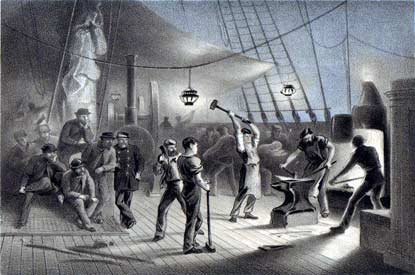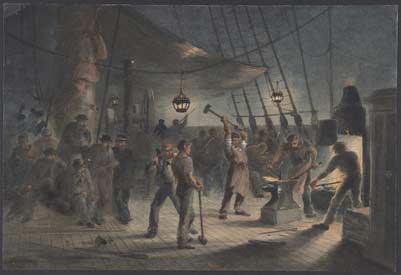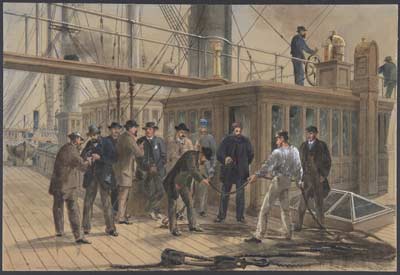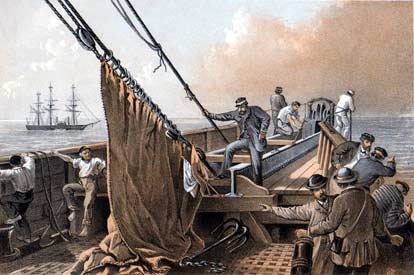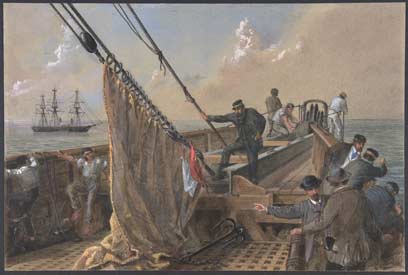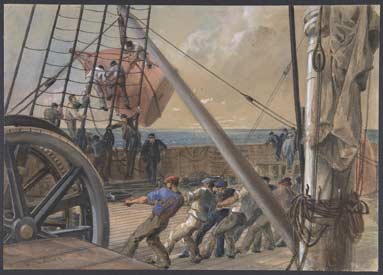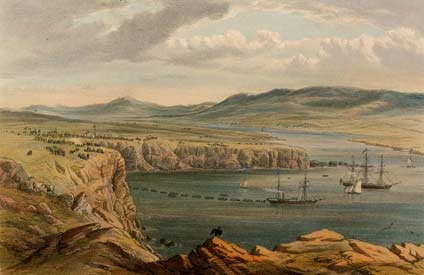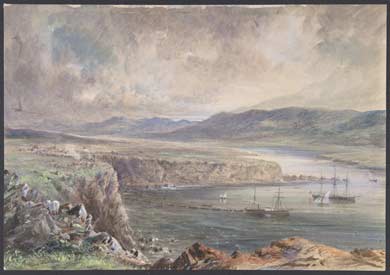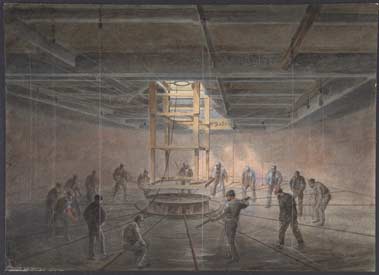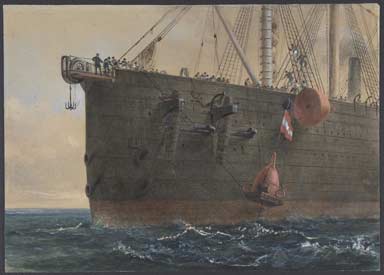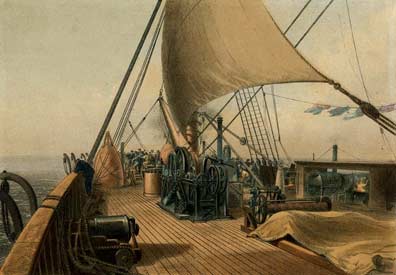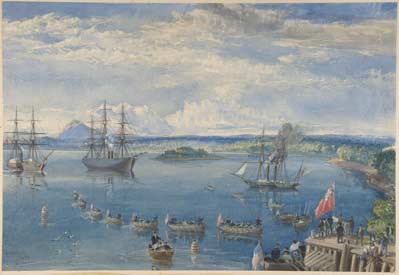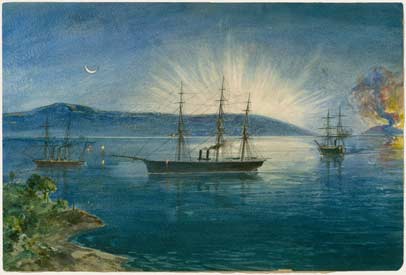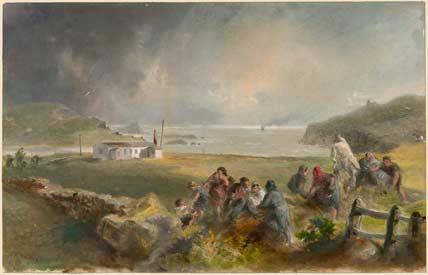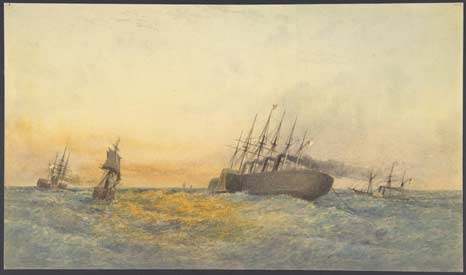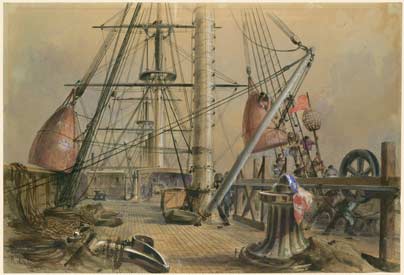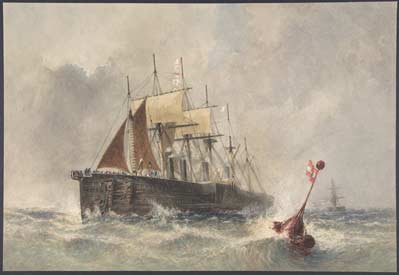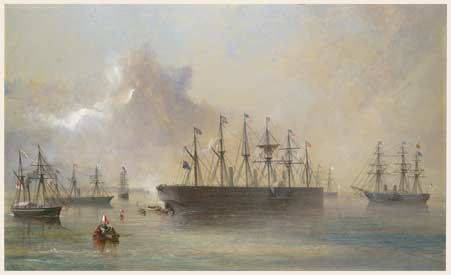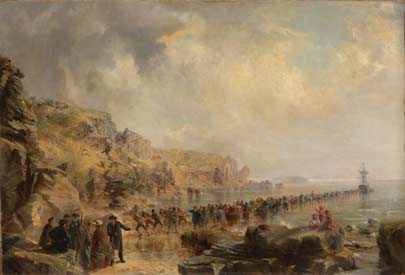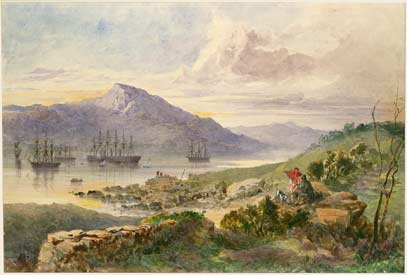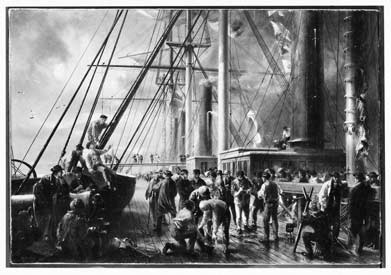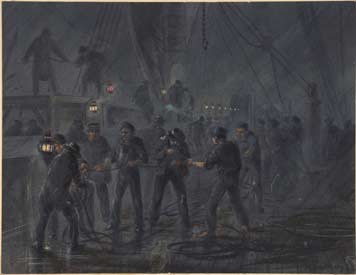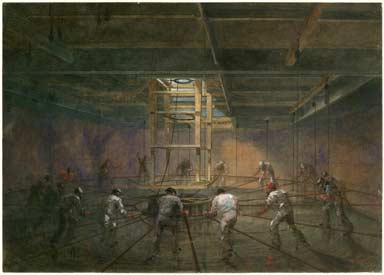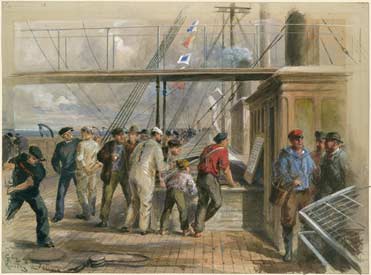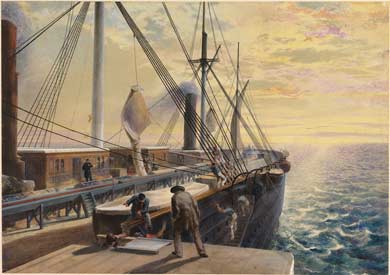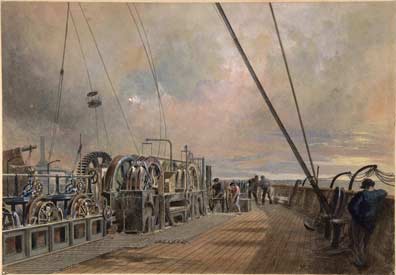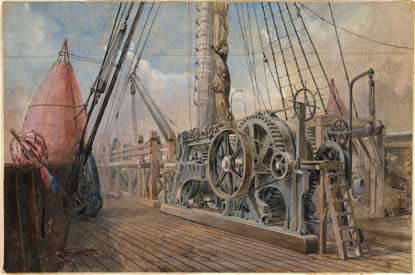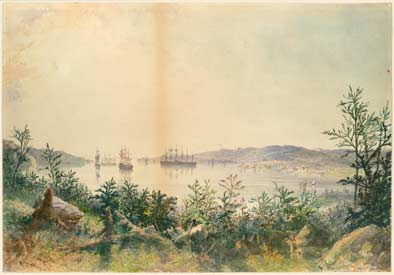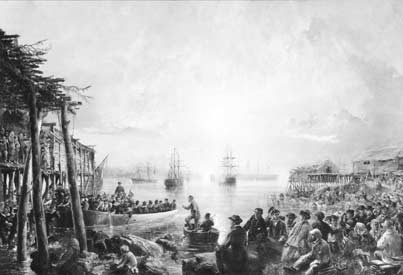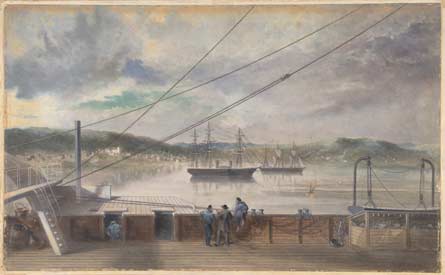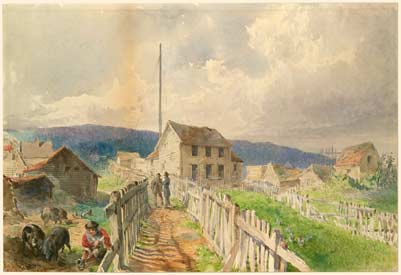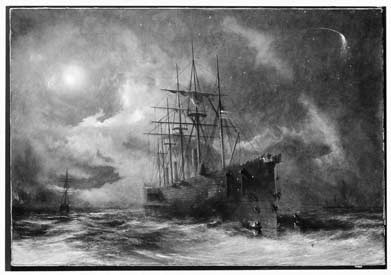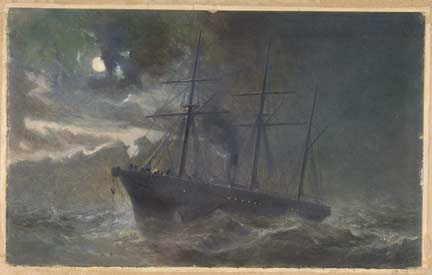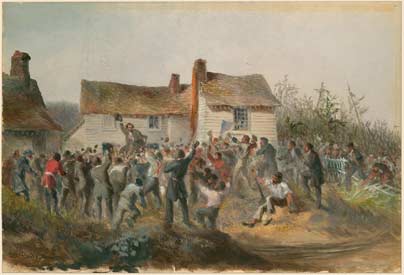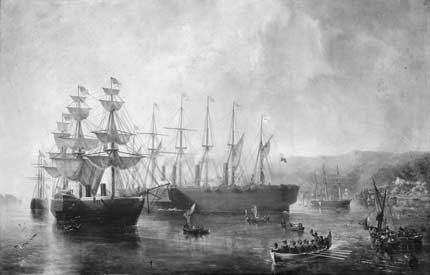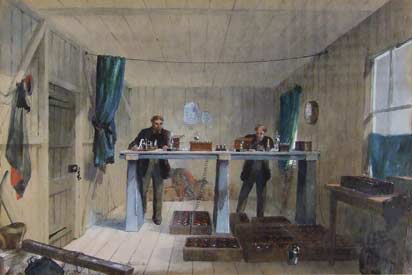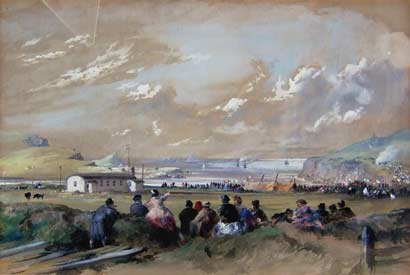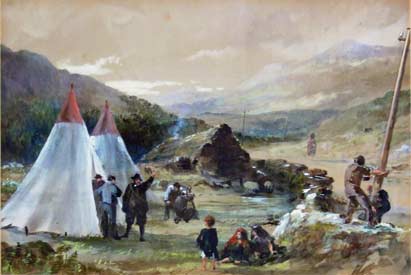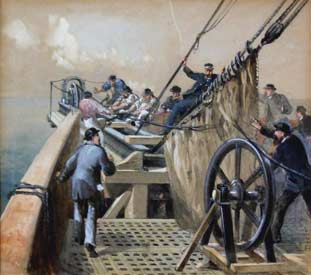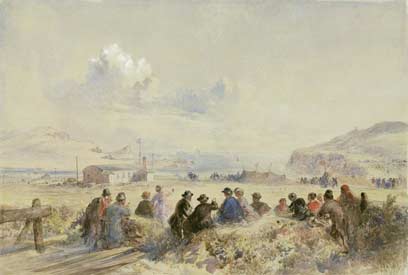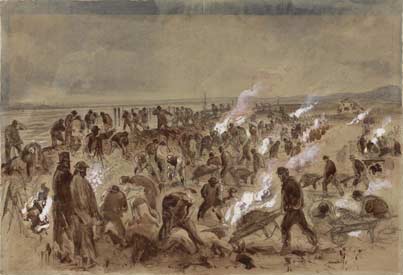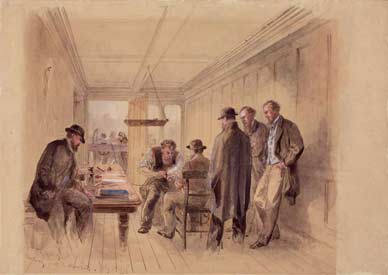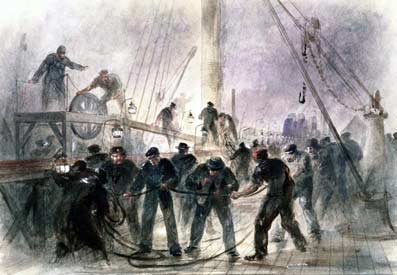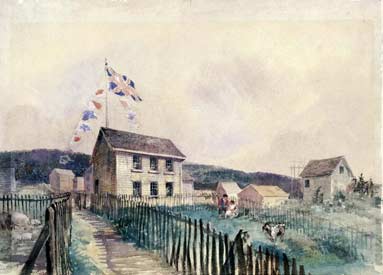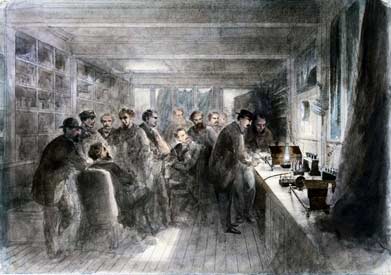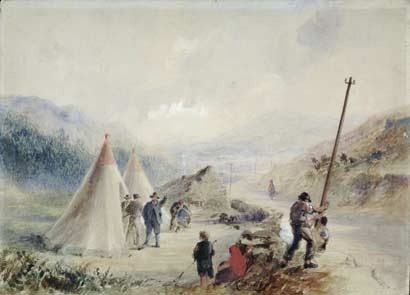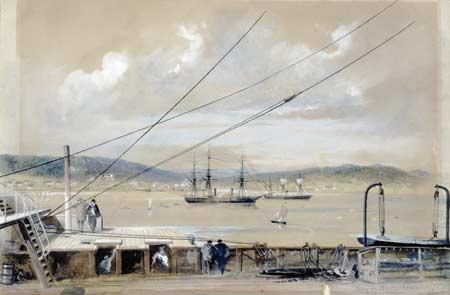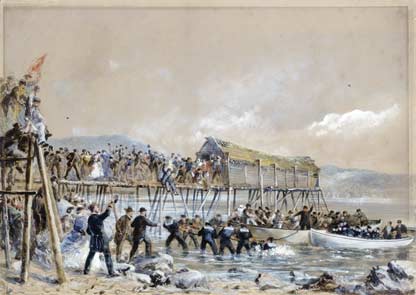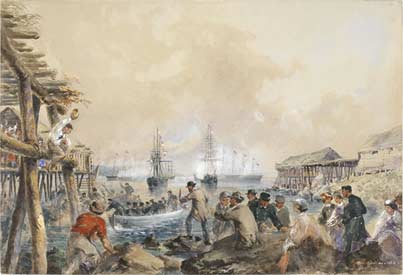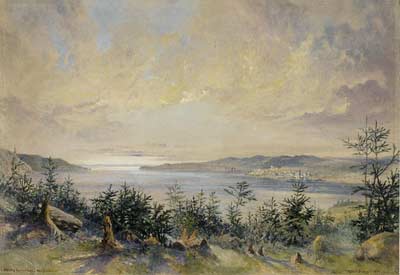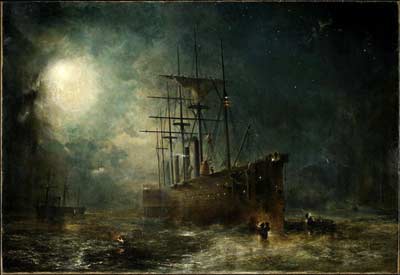History of the Atlantic Cable & Submarine Telegraphy (original) (raw)
W.H. Russell
Photograph by
Roger Fenton, 1855.
LoC LC-USZC4-9183
William Howard Russell’s book is perhaps the most spectacular work on the Atlantic Cable, with lithographs after the original watercolours made by Robert Charles Dudley on the 1865 Great Eastern cable expedition, along with others made by Dudley at that time representing scenes from the earlier expeditions. Page size is 11¼" x 8"; image size approximately 8¾" x 6", and the publisher was Day and Son, Limited, a firm which specialized in “Illustrated Works in Chromo-Lithography, &c.”
The book carries no publication date, although it is often listed as 1866, and the publisher’s advertisements in the trade publication The Bookseller give the status of the book as “Preparing” on 31 October 1865 and again on 12 December 1865. However, in its 30 December 1865 issue (page 1149), The Bookseller included “The Atlantic Telegraph,” priced 21/-, under “Illustrated Books” in the section “Publications of the Months, November and December,” and also in “Alphabetical List of the Principal English Publications for the Month Ending December 30” (page 1203). These listings confirm that the publication date of “The Atlantic Telegraph” was in fact December 1865.
A review of the book appeared in The Times on 11 December 1865.
In 2005 Nonsuch Publishing released a new paperback edition of Russell’s book, with full-colour illustrations and the complete text of the original. See the Current Bibliography page for more information. The full text of the book, with monochrome images, is available at Project Gutenberg.
Probably soon after the publication of the book, Cyrus Field bought from Robert Dudley six oil paintings and forty water-colour drawings, including those used in the book. We know from the survival of an elaborate invitation, illustrated by Dudley, that Field then exhibited the pictures at his Gramercy Park residence in New York City. The invitation promised visitors “...a Private View Of a Series of Pictures By Mr. Robert Dudley, of London, Representing the Principal Incidents Connected with the Atlantic Telegraph Expeditions. Gramercy Park, New York.”
In 1892, all of these paintings and watercolours, along with other cable memorabilia from his collection, were given by Field to the Metropolitan Museum of Art in New York, and they remain in the Museum’s collection today. The invitation to Field's private view included a detailed description for each of the oil paintings, and these captions are reproduced in the Metropolitan Museum section.
Shown immediately below is a complete set of the images from the original 1865 publication (the title page, 24 coloured lithographs, and the chart of the voyage, 26 plates in all), alongside the original art for each image where available. The images and captions in the left-hand column are from Russell’s book, while the same scenes in the right-hand column are Robert Dudley’s original watercolours, with captions from the Met’s catalog entries. The accession number links at the beginning of each line are to the Met’s page for each image, where high-resolution scans may be downloaded. A number of Dudley’s watercolours and paintings in the museum’s collection were not used in Russell’s book, and these are shown at the end of the section.
The Institution of Engineering and Technology (IET) Archives in London has four additional cable watercolours by Dudley; these are also reproduced here by kind permission of the IET. Three further watercolours are shown courtesy of Library and Archives Canada: Peter Winkworth Collection of Canadiana, and seven others are reproduced by kind permission of the Science Museum (London) Science & Society Picture Library.
The Book: The Atlantic Telegraph
Front cover of Standard Edition
The contract for the book suggested the possibility of inserting a “veneer” or thin slice of the actual cable into the cover of the book, but this was not done. A drawing of the cable cross-section was used instead.
Title Page of Deluxe Edition
92.10.57: The Great Eastern weighing anchor off the Maplin Sands at the Nore, July 15, 1865
In this column:
Coloured lithographs, as
published in Russell’s book
In this column:
Original artwork, courtesy of
the Metropolitan Museum of Art
Title Page of Standard Edition
The Atlantic Telegraph
By W.H. Russell L.L.D.
Illustrated by Robert Dudley
Dedicated by
Special Permission
to His Royal Highness
Albert Edward Prince of Wales
Day & Son Limited
6 Gate Street London
Weighing Anchor off the
Maplin Sands, Nore, July 15th
Title Page 92.10.100: The Great Eastern Weighing Anchor off the Maplin Sands at the Nore, July 15, 1865

Page 14: The reels of gutta-percha-covered conduction-wire conveyed into tanks at the works at Greenwich.
92.10.52: The reels of gutta-percha covered conducting wire conveyed into tanks at the Works of the Telegraph Construction and Maintenance Company, at Greenwich
Page 18: Valentia in 1857-58 at the time of the laying of the former cable.
92.10.85: Valentia in 1857-1858 at the Time of the Laying of the Former Cable
[An inscription on the back of this painting describes the scene as “Heart’s Content”, but the location has been confirmed as Valentia]
Page 26: Trinity Bay, Newfoundland: exterior view of telegraph house in 1857-58.
92.10.49: Trinity Bay, Newfoundland, Exterior View of the Telegraph House, 1858
Page 28: Telegraph house, Trinity Bay, Newfoundland: interior of messroom, 1858.
92.10.50: Telegraph House, Trinity Bay, Newfoundland: Interior View of the Mess Room, 1858
Page 28: H.M.S. Agamemnon laying the Atlantic telegraph cable in 1858: a whale crosses the line.
92.10.68: H.M.S. Agamemnon laying the Atlantic Cable in 1858; a whale across the line
Page 36-7: Coiling the cable in the large tanks at the works at Greenwich.
92.10.53: Coiling the Cable in the large tanks at the works of the Telegraph Construction and Maintenance Company of Greenwich, 1865
Page 38: The cable passed from the works into the hulk lying in the Thames at Greenwich.
92.10.54: The Cable passed from the works into the hulk (the old frigate Iris) lying in the Thames at Greenwich
Page 39: The old frigate with her freight of cable alongside the Great Eastern at Sheerness.
92.10.55: The old frigate Iris with her freight of cable alongside the Great Eastern at Sheerness. The cable passed from the hulk to the Great Eastern
Page 40: Paying-out machinery
92.10.63: The paying out machinery in the stern of the Great Eastern
Page 42: Coiling the cable in the after-tank on board the Great Eastern at Sheerness: visit of H.R.H. The Prince of Wales on May 24.
92.10.56: Coiling the cable in the after tank on board the Great Eastern at Sheerness. Visit of H.R.H. the Prince of Wales on May 23rd, 1865
Page 44: Foilhummerum Bay, Valentia, looking seawards from the point at which the cable reaches the shore.
92.10.58: Foilhommerum Bay, Valentia, looking seawards from the point at which the Cable reaches the shore of Ireland
Page 46: The cliffs, Foilhummerum Bay: point of the landing of the shore end of the cable, July 22.
92.10.60: The Cliffs, Foilhommerum Bay, Valencia, the Point at which the shore end of the Cable was landed on July 22nd, 1865
Page 48: Foilhummerum Bay, Valencia, from Cromwell Fort: the Caroline and boats laying the earth-wire, July 21.
92.10.61: General View of Point Magee and Foilhommerum Bay, Valencia, from the heights below Cora Beg. The Caroline laying the shore end of the Cable on July 22nd, 1865
Page 52: The Great Eastern under weigh, July 23: escort and other ships introduced being the Terrible, the Sphinx, the Hawk, and the Caroline.
92.10.88: Telegraph Cable Fleet at Sea, 1865
Page 56: Chart, showing the track of the steam-ship Great
Eastern on her voyage from Valentia to Newfoundland.
Detail of recovery attempts.
Page 57: Splicing the cable (after the first accident) on board the Great Eastern, July 25.
92.10.64: Splicing the Cable (after the first accident) on board the Great Eastern, July 25th, 1865
Page 63: View (looking aft) from the port paddle-box of Great Eastern: showing the trough for cable, etc
92.10.89: Deck of Great Eastern
Page 68: The forge on deck; night of August 9: preparing the iron plating for capstan.
92.10.71: The Forge on Deck, Night of August 9th. Preparing the iron plating for capstan.
Page 71: Searching for fault after recovery of the cable from the bed of the Atlantic, July 31.
92.10.67: Searching for the fault after hauling back the cable from the bottom of the Atlantic, July 31st, 1865
Page 77: In the bows, August 2: the cable broken and lost: preparing to grapple.
92.10.72: Forward deck of the Great Eastern cleared for the first attempt to grapple for the lost cable, August 11th, 1865
Page 79: Getting out one of the large buoys for launching, August 2.
92.10.69: Getting out one of the Ocean buoys for launching, August 2nd, 1865
Page 80: General view of Port Magee, &c., from the heights below Cora Beg; the Caroline laying the shore end of the cable, July 22.
92.10.59: Foilhommerum Bay, Valentia, looking from Cromwell Fort. The Caroline and boats laying the earth wire, July 21st, 1865
Page 86: Interior of one of the tanks on board the Great Eastern: cable passing out.
92.10.66: Interior of one of the tanks on board the Great Eastern. The cable passing out
Page 88: Launching buoy on August 8, in Lat. 51 23' 30"; Long. 30 46' (marking spot where cable had been grappled).
92.10.51: In the bows of the Great Eastern. The cable broken and lost, preparing to grapple, August 2nd, 1865
Page 93: Forward deck cleared for the final attempt at grappling, August 11.
92.10.83: The Picking up Machinery in the bows of the Great Eastern
End of plates and artwork as published in The Atlantic Telegraph
The Robert Dudley oil paintings and watercolours shown in the next two sections are also from the Gift of Cyrus W. Field, 1892, at the Metropolitan Museum of Art, and the images are displayed here courtesy of the Museum: www.metmuseum.org. All are watercolours unless noted as [Oil]. The Museum website has only black and white images of four of the oil paintings.
This group of images includes six pieces painted in 1865 which were not used in the book (with some scenes from 1857/58), and nineteen others from the 1866 expedition. They are shown here in approximate chronological order of the events depicted.
Metropolitan Museum 1858 Watercolours
92.10.90: The cable fleet leaving Ireland, July 1858
This painting, together with illustrations reproduced from the book's lithographs, appeared in an article on the Atlantic Cable by Arthur C. Clarke, published in American Heritage magazine, October 1958.
92.10.91: The Bay of Bull Arms, Trinity Bay, Newfoundland. Bonfires lighted on the hills to notify of the arrival of the cable fleet on August 5th, 1858
Although catalogued at the Met as by Robert Dudley, the paintings above are not in his style. The left-hand image has the signature “Wm Simpson 1858” clearly visible at the bottom left of the painting. On the right-hand image, a signature at the bottom right, although indistinct, also appears to be that of Wm Simpson when viewed under high magnification. Compare the two signatures - both include the date of 1858 with a line below. Like Dudley, William Simpson worked for Day & Sons.
Josephine C. Dobkin’s 2006 article "The Laying of the Atlantic Cable: Paintings, Watercolors, and Commemorative Objects Given to the Metropolitan Museum by Cyrus W. Field" in the Metropolitan Museum Journal correctly attributes the first painting to Simpson, but not the second one. Note also that the article was published before Robert Dudley’s date of death was corrected to 1909.
Metropolitan Museum Additional 1865 Watercolours
92.10.48: Valentia, Ireland, from the Harbor, Opposite Knight’s-town, at the Period of Laying the Cable of 1857
This is clearly mistitled at the Met, as the scene shows the
cable hut at Foilhommerum Bay, which was not built until 1865.
Compare with “Watching Maneuvers from the Dunes” below
92.10.62: The Great Eastern under weigh, July 23rd, 1865. Escort and other ships, H.M.S. Terrible, H.M.S. Sphinx, the Hawk and the Caroline
92.10.82: Getting out one of the great buoys. The deck of the Great Eastern looking from the forecastle
92.10.70: Launching the buoy from the bow of the Great Eastern on August 8th, 1865
Metropolitan Museum 1866 Watercolours and Oil Paintings
92.10.73: The Atlantic telegraph cable fleet assembled at Berehaven (S.W. Coast of Ireland). July 1866
92.10.44 [Oil]: Landing the Shore End of the Atlantic Cable [at Valentia].
Depicted are Sir Richard Glass, the Knight of Kerry, Mr. Cromwell F. Varley, Mr. Latimer Clark, Mr. N. Woods, Mr. Cyrus W. Field, and others.
92.10.74: The heights over Foilhommerum Bay, Valencia, the William Corey heading seawards, laying the shore end of the Atlantic Telegraph Cable, July 7th, 1866
92.10.47 [Oil]: Atlantic Telegraph Cable Expedition of 1866— / Making the splice between the shore end and the Ocean Cable on board / the “Great Eastern,” off Valencia. Latde 51°-50' Longde 11°-6' / July 13th 1866
Depicted are Captain Sir James Anderson, Sir Samuel Canning, Staff-Commander Henry A. Moriarty, C.B., Sir Daniel Gooch, Bart., Professor Sir William Thomson, Mr. Willoughby Smith, Mr. Henry Clifford. Mr. John Temple, Mr. J.C. Deane. Captain A.T. Hamilton, Mr. R. Dudley, Mr. Cyrus W. Field, and others.
92.10.77: A Night Scene. The cable entangled and nearly broken, July 18th, 1866
92.10.76: View of the interior of one of the tanks on board the Great Eastern
92.10.84: News Received through the Atlantic Cable from all parts of the world, etc. [July 22nd 1866]
Going off duty / Reading the News
92.10.65: View looking aft from the port paddle box of the Great Eastern, showing the trough for the Cable, etc.
92.10.75: Deck of Great Eastern, aft, the paying out machinery
92.10.78: Deck of the Great Eastern, the cable trough, etc., 1866
92.10.79: Arrival in Trinity Bay, Newfoundland. The cable passed to the paddle box boat of the Terrible, etc.
92.10.46 [Oil]: Landing at Newfoundland
Compare with the watercolour below
Depicted are Sir Samuel Canning, Captain Sir James Anderson, Captain Commerell, V.C., C.B., of H.M.S. “Terrible,” Sir Daniel Gooch, Bart., Mr. H. Clifford, Mr. Willoughby Smith, Professor Sir William Thomson, Captain A.T. Hamilton. Mr. J.C. Deane, Staff-Commander H.A. Moriarty, Lieutenants Stretfield, Arundell, and Elliot, of H.M.S. “Terrible,” Mr. Cyrus W. Field, and others.
92.10.80: The Settlement and Church of Heart’s Content, Newfoundland
92.10.86: First Telegraph House at Hearts Content, Newfoundland, 1866
Compare with the similar scene below.
92.10.45 [Oil]: Grappling for the Lost Cable [1866]
Ships engaged—The “Great Eastern,” the “Medway,” and the “Albany.”
92.10.43 [Oil]: Awaiting the Reply
[1 September 1866]
Compare with “Transmitting” below
Depicted are Mr. Willoughby Smith, Professor Sir William Thomson, Sir Samuel Canning, Captain Sir James Anderson, Sir Daniel Gooch, Bart., Mr. Henry Clifford, Mr. Oliver Smith, Mr. J.C. Laws, Captain A.T. Hamilton, Mr. John Temple, Mr. Griffiths, Staff-Commander H.A. Moriarty, C.B., Dr. Ward, and Mr. Cyrus W. Field.
92.10.81: The Albany buoying a bight of the cable of 1865 on the night of August 26th, 1866
92.10.87: September 8th at Heart’s Content, the day of the successful termination of the work of laying, recovering, completing and testing the Atlantic Telegraph Cables of 1865 and 1866
Compare with the similar scene below
92.10.42 [Oil]: Homeward Bound: “The _Great Eastern_”
Captioned in Henry Field’s book, 1892: “Mr. Field leaving the Great Eastern”
On the viewing invitation: Mr. Field’s departure from the “Great Eastern.” Ships—The “Great Eastern,” the “Medway,” H.M.S. “Terrible,” H.M.S. “Lily,” and others.
End of images from the Metropolitan Museum of Art Link to list of all Dudley artwork at the Met
IET 1865 Watercolours
The Institution of Engineering and Technology (IET) in London, founded in 1871 as the Society of Telegraph Engineers, has in its archives four Robert Dudley watercolours from the 1865 Atlantic cable expedition which were deposited by Mr Percy Rosling in 1934. Images of these watercolours are reproduced here by kind permission of the IET Archives.
Interior of cable hut, Valentia, Ireland
IET Archives: UK0108 OPC/1/37/01
Bringing in the cable (shore end) at Valentia
IET Archives: UK0108 OPC/1/37/02
Erecting land lines in the Irish interior.
IET Archives: UK0108 OPC/1/37/04
Compare with the similar scene below
Breaking of deep sea cable on board the Great Eastern, near Heart’s Content, Newfoundland
IET Archives: UK0108 OPC/1/37/03
Science Museum 1865 & 1866 Watercolours
The Science Museum in London has six Robert Dudley watercolours made on the 1866 Atlantic cable expedition and one painted in 1865 at the same time as Dudley’s other views of the 1857/58 expeditions, some of which were published in Russell’s book.
Images of these seven watercolours are reproduced here by kind permission of the Science Museum, which also has many cable-related artefacts in its collection.
Watching Manoeuvers from the Dunes, Foilhummerum Bay, Valentia
Science Museum 1985-2294
A version of this painting was published as a wood engraving
in The Illustrated London News issue of 5 August 1865
[Compare with “Valentia...at the Period of Laying the Cable of 1857” above, which is clearly mistitled]
Laying the line
Science Museum 1979-355 Pt4
Making joint to Shore End [13 July 1866]
Science Museum 1979-355 Pt3
The Foul Flake, night of July 17 [1866]
Science Museum 1979-355 Pt5
The Telegraph Station in Heart’s Content Bay
Science Museum 1979-355 Pt6
Compare with the similar scene above.
Transmitting
Science Museum 1979-355 Pt2
[Published in the Illustrated London News, 13 October 1866
Compare with “Awaiting the Reply” above]
Chairing Canning at Heart’s Content
[8 September 1866 ]
Science Museum 1979-355 Pt1
Compare with the similar scene above.
Library and Archives Canada 1866 Watercolours
Library and Archives Canada has three Robert Dudley watercolours of the Atlantic cable expeditions from the Peter Winkworth Collection of Canadiana. Images of these watercolours are reproduced here by kind permission of the Library.
Erecting the land line for the Trans Atlantic Cable.
Library and Archives Canada, Acc. No. R9266-177 Peter Winkworth Collection of Canadiana
Compare with the similar scene above
Heart’s Content Bay, Newfoundland,
seen from the deck of the Great Eastern.
Library and Archives Canada, Acc. No. R9266-176 Peter Winkworth Collection of Canadiana
Landing of the Atlantic Cable of 1866
at Heart’s Content, Newfoundland.
Library and Archives Canada, Acc. No. R9266-175 Peter Winkworth Collection of Canadiana
Compare with the oil painting above
Royal Ontario Museum 1866 Watercolours and Oil Painting
The Royal Ontario Museum, Toronto, Canada, in its Sigmund Samuel collection, has one oil painting and two watercolours by Robert Dudley with scenes of the 1866 Atlantic cable expedition.
Low-resolution images of these works are reproduced here under the Fair Dealing provision of the Canadian Copyright Act, courtesy of rom.on.ca.
Heart's Content Bay, Newfoundland,
Arrival of Transatlantic Cable
Royal Ontario Museum, rom.on.ca
Gift of the Sigmund Samuel Endowment Fund
Compare with the watercolour immediately above
Heart's Content Bay, Newfoundland:
View of the Town
Royal Ontario Museum, rom.on.ca
Gift of the Sigmund Samuel Endowment Fund
The Great Eastern Recovering the Lost Atlantic Cable
Royal Ontario Museum, rom.on.ca, object number 956-200
Gift of the Sigmund Samuel Endowment Fund
William Russell Correspondence
| This interesting letter from William Russell to Robert Dudley is dated Nov. 19, 1865, and discusses the book. |
|---|
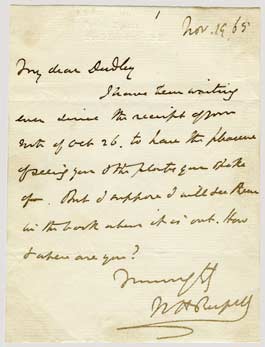 18 Sumner Place Onslow Square South Kensington SW Nov. 19 65 My dear Dudley I have been waiting ever since the receipt of your note of Oct 26. to have the pleasure of seeing you and the plates you spoke of. But I suppose I will see them in the book when it is out. How and where are you? Yours always truly WH Russell 18 Sumner Place Onslow Square South Kensington SW Nov. 19 65 My dear Dudley I have been waiting ever since the receipt of your note of Oct 26. to have the pleasure of seeing you and the plates you spoke of. But I suppose I will see them in the book when it is out. How and where are you? Yours always truly WH Russell |
Russell also stayed in touch with Sir James Anderson, captain of the Great Eastern on the 1865 cable expedition. Russell’s sons Willie and Johnny had accompanied him on that voyage, and in 1869 Russell wrote to Anderson requesting help with placing his son John into telegraphy: 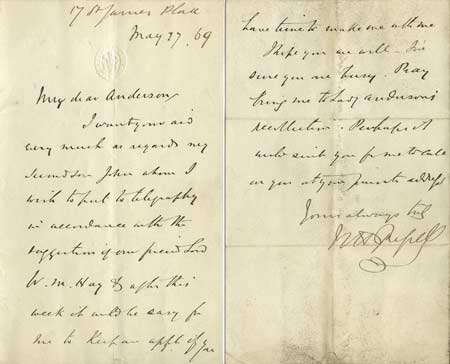 17 St James Place May 17 69 My dear Anderson, I want your aid very much as regards my second son John whom I wish to put to telegraphy in accordance with the suggestion of our friend Lord W.M. Hay & after this week it would be easy for me to keep an appt. if you have time to make one with me. I hope you are well - I’m sure you are busy. Pray bring me to Lady Anderson’s recollection. Perhaps it would suit you for me to call on you at your private address [?]. Yours always truly WH Russell 17 St James Place May 17 69 My dear Anderson, I want your aid very much as regards my second son John whom I wish to put to telegraphy in accordance with the suggestion of our friend Lord W.M. Hay & after this week it would be easy for me to keep an appt. if you have time to make one with me. I hope you are well - I’m sure you are busy. Pray bring me to Lady Anderson’s recollection. Perhaps it would suit you for me to call on you at your private address [?]. Yours always truly WH Russell 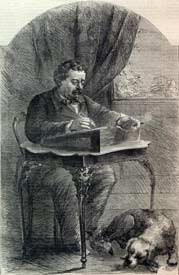 W.H. Russell Harper’s, 22 June 1861 Russell also had a long-standing correspondence with Lord William Hay, 10th Marquess of Tweeddale, whom he mentions in his letter to Anderson. Russell’s letters to Hay are held by the National Library of Scotland, reference MS 14467. Lord William Hay was a director of the Anglo-American Telegraph Company. Source: Broadside entitled “The Marine Electric Telegraphs Bill. Speeches by Mr Cyrus W. Field and Lord WM. Hay, before the Senate Committee, Saturday March 13th” [1875, Senate of Canada]. Lord Hay was also chairman of the Malta and Alexandria Telegraph Company W.H. Russell Harper’s, 22 June 1861 Russell also had a long-standing correspondence with Lord William Hay, 10th Marquess of Tweeddale, whom he mentions in his letter to Anderson. Russell’s letters to Hay are held by the National Library of Scotland, reference MS 14467. Lord William Hay was a director of the Anglo-American Telegraph Company. Source: Broadside entitled “The Marine Electric Telegraphs Bill. Speeches by Mr Cyrus W. Field and Lord WM. Hay, before the Senate Committee, Saturday March 13th” [1875, Senate of Canada]. Lord Hay was also chairman of the Malta and Alexandria Telegraph Company |
The Publication of the Book
| Almost nothing has been written on the origins of Russell’s book, except that he was engaged to write it by the Telegraph Construction & Maintenance Company. But in the Telcon archive at the National Maritime Museum is a copy-book of contracts for the 1865 expedition, a hardbound volume containing copperplate handwritten copies of the agreements among some of the parties to the project. These were: The Telegraph Construction & Maintenance Company, which made and laid the cable; the Atlantic Telegraph Company, its promoter; Webster & Horsfall, the supplier of 1,667 tons of armouring wire; Gillespy & Scott, provider of 6,000 tons of coal for the Great Eastern; and Day & Son and William H. Russell for the writing and publication of the book. Also included are further contracts for the following year with the Anglo-American Telegraph Company, and The Great Eastern Ship Company. As well as writing the text for the book, Russell kept a daily diary of the events on board ship. This was reproduced by lithography during the expedition in many copies, and was intended to be sent to 65 newspapers in Britain and 25 in North America immediately after the conclusion of the voyage. The full text of the agreements for Russell’s book is reproduced below. Russell was a freelance writer, and so had his own contract with Telcon, while Robert Dudley was a regular artist for Day & Son, and was presumably paid by them directly. London, 1 May 1865 In consideration of your engaging to purchase from the Company of Day & Son (Limited) one thousand copies of the First Edition (which is not to exceed 2050 copies) of the Volume illustrated as agreed between the undersigned the Managing Director of the Company, and Mr. John C. Deane at one guinea each, and to pay for the same on delivery, and to afford to the Company and its Artists every facility in your power for the production of the necessary views and details for illustration. The Company agrees to undertake the whole risk and expenditure of producing and publishing the work – being provided by you free of cost with letter press from the pen of W.H. Russell, Esq. L.L.D. or failing his writing the same from the pen of some other competent person descriptive of the laying of the New Atlantic Telegraph Cable and of other matter incidental to the History of Submarine Telegraphy. And if you think it advisable being provided free of cost with Veneers of the Atlantic Cable for insertion in the Cover of the Volumes. We undertake to issue the first edition (limited as aforesaid) with all possible despatch after the delivery of the letter press to us and to deliver you one thousand Copies within fourteen days after the publication of the work. The Copyright of the second and any subsequent editions is to be vested in you and the Company agrees to publish any further edition that you may require, you agreeing to purchase and on deliver to pay for any number of Copies up to Five Hundred at the price of 10/. each and if more than five hundred be required to purchase and on delivery to pay for not less than one thousand Copies at the price of 8/. each and as many more copies as you may require the Company to publish. On behalf of Day & Son Limited Wm. Day Managing Director To R.A. Glass, Esq. Managing Director Telegraph Construction & Maintenance Co. Limited 54 Old Broad St. E.C. London, 1 May 1865 To Day & Son Limited Gale Street Lincoln’s Inn Fields. In consideration of your Company undertaking the whole risk and expenditure of producing and publishing a volume illustrated as agreed between the Managing Director Mr. William Day and Mr. John C. Deane according to the agreement of which a copy of which is hereunto annexed I agree to provide the Company free of cost with the necessary letter press from the pen of W.H. Russell, Esq. L.L.D. or failing his writing the same from the pen of some other competent person and if I think it advisable with Veneers of the Atlantic Cable for insertion in the Cover of the Volumes And I agree to purchase from the Company 1,000 copies of the First Edition of the volume such first edition not to exceed 2,050 copies and to pay for the same on delivery at the rate of one guinea each. The Copyright of any subsequent editions is vested in me and if I require your Company to publish another edition I engage to purchase and on delivery to pay for any number of Copies up to Five Hundred at the price of 10/. each and if more than 500 be required to purchase and on delivery to pay for not less than 1,000 Copies at the price of 8/. each and as many more Copies as I may require the Company to publish. R.A. Glass Managing Director Telegraph Construction & Maintenance Company Limited 54 Old Broad St. E.C. London, June 9th 1865 To R.A. Glass, Esqre. Telegraph Construction & Maintenance Company 54 Old Broad St. Dear Sir, I propose to proceed in the Great Eastern Steamer on the voyage on which she is now about to take for the purpose of laying the Atlantic Cable between Valentia & Newfoundland, and to prepare and furnish to you acting on behalf of the Directors of The Telegraph Construction & Maintenance Co. a full account of the incidents of the voyage as well as of all such other matters in relation to the subject as may be of interest, giving you full liberty to publish such account and derive all advantages from it without any reservation in my favour. I make this proposal on and subject to the following terms and conditions— First—That I shall receive from you on behalf of the Directors of The Telegraph Construction & Maintenance Co. a sum of Six hundred pounds (£600)—one moiety thereof to be paid to me on the acceptance of this proposal, and the other moiety on the final completion of my part of the Agreement— Secondly—That in the event of the undertaking proving successful The Directors are further and in addition to transfer into my name so many fully paid up Shares of the Company as they may consider me entitled. W.H. Russell. London, 54 Old Broad St. June 16th 1865 To William Howard Russell Dear Sir On my own behalf and on that of The Directors of The Telegraph Construction & Maintenance Company I accept the above proposal and agree to carry out its provisions. R.A. Glass as Managing Director. |
|---|
| While the book has no date of publication, The Times published this review in its issue of 11 December 1865: The Times, 11 December 1865 THE ATLANTIC TELEGRAPH.* The story of the late, and, possibly, for some time to come of the last, Atlantic expedition has just been issued. When we say that its author is Mr. Russell, that its illustrator is Mr. Dudley, and that its publishers are Messrs. Day and Son, our readers will easily believe that the matter is good, the drawings spirited and beautifully lithographed, and the general style of the book such as is likely to make it the permanent record of one of the most extraordinary enterprises which were ever undertaken in the interests of commerce. The book at the very outset disclaims all pretensions to being considered a scientific history, or almost even a history, of the great expeditions so often made, and, with one exception, always unsuccessful. It is a vivid story of the last effort made from the Great Eastern, the narratives of former attempts being condensed into a brief sort of preface that serves to bring the latest expedition before the reader. No one can read this last narrative without a feeling of regret that Mr. Russell did not do the same by the former attempts. The last was, of course, very interesting, but those which preceded it were almost equally so. The records of the first great trial of all, with a sketch of its almost endless mistakes and mismanagements, would now read well side by side with an account of the elaborate care and foresight with which the last attempt was organized. So, also, with the second effort, when the Agamemnon and Niagara were terribly overladen, when the former was so near foundering in the storm, and when, after her dreary cruise in search of the Niagara, she had at last to give up the attempt, and return to Queenstown a fortnight after all the rest of the squadron, and just as people had abandoned the hope of ever seeing her again, Mr. Russell gives much fuller details of the third and only successful expedition, when the ill-made, ill-stowed, and generally ill-used cable was at last laid successfully. He is also careful to place before us a record of the messages sent through it, including those between Her Majesty and the President. We are very glad of this, for there is a most stupid, though very prevalent, notion abroad that both messages and replies were concocted, and that nothing was ever really sent though the wire, A moment's consideration will show that this was altogether impossible, unless Her Majesty and Mr. Buchanan were parties to such an imposture, and each consented to have imaginary messages and imaginary replies given to the world as coming from themselves. Even apart from these, however, there was the account of the collision of the Arabia with the Europa; the Admiralty used the wire in their instructions to vessels, and the War-office in countermanding the departure of two regiments from Canada; and any one who was ever in the receiving-house at Valentia knows well that for one such public message sent there were twenty private injunctions sent from electrician to electrician at either side. It was not till the cable had been in fair working order for nearly three weeks that it began to show signs of yielding, and then its disease made rapid progress. Flickering faintly, the needle on the dial moved vaguely to and fro, now making itself understood for a few minutes, then rambling incoherently like the speech of a dying man. With the same care and solicitude as if it had been a sentient being, indeed, was its decay watched, till, in the night, the needle violently oscillated, and then stood still for ever. The test signals gave “dead earth," and the first and only Atlantic cable ever laid was hopelessly defunct. Its insulation, always defective, had been at last destroyed by the overwhelming battery power employed to force the signals through. The only wonder is now that such a wire could ever have been got to work at all. Mr. Russell gives us an ample account of the last expedition, and almost every page of his vigorous description is illustrated in the most perfect manner by Mr. Dudley. The Great Eastern, with its ponderous tanks, and still more ponderous supports, the modes of manufacture, modes of testing--everything, in fact, from the first idea of the improved cable till the last dreadful moment when it broke away in mid-Atlantic, is placed before us by this book either in pictures or in words which are almost more vivid. It is a pity that, with such a historian and such a subject, the expedition was not more fortunate in its results. If it is again attempted, and Mr. Russell is again its chronicler, let us hope that he will give us a fuller account of the first attempts, and that then we shall not have to lay his book down, as many readers will do now, with an earnest wish that there was more of it. *The Atlantic Telegraph. By W.H. Russell, LL.D. London: Day and Son. The book was also favourably received by The Popular Science Review, Vol. V, 1866: THE ATLANTIC TELEGRAPH. The beautiful volume before us is a fitting record of the great labour which last year saw begin and terminate. It is the history of the voyage, written by Dr. W.H. Russell, and while it is instructive and interesting as a narrative, it is highly ornamental as a sketch-book. Messrs. Day and Sons have reproduced Mr. Dudley’s drawings in the best style of chromolithography, and altogether the book is one of which it would be hard to speak too favourably. Dr. Russell gives an account of the earlier efforts to unite the old and new continents, and shows us that the first submarine telegraph cable projected on the other side of the Atlantic was the scheme of an English engineer. The melancholy circumstances attending the rupture of the cable are conveyed as only Dr. Russell is capable of conveying them. Every little incident in connection with the great project is sketched with minuteness, and the reader’s attention and sympathies are excited and engaged by this fascinating writer. Perhaps the most noteworthy portion of the work is that which refers to the probability of success attending the next effort to lay the cable. The cable of 1865, though capable of bearing a strain of seven tons, did not experience more than 14 cwt. in being paid out into the deepest water of the Atlantic. Owing to the improvements introduced into the manufacture of gutta-percha, it insulated a hundred times better than cables made in 1858, and still working. The improvements, too, effected since the beginning of 1851 in the conducting power of the copper wire, by selecting it, have increased the rate of signalling through long submarine cables by more than 33 per cent. Now, if a steam-engine be attached to the paying-out machinery, so as to permit of hauling in the cable immediately a fault is discovered, and a slight modification made in the construction of the external sheath, the cause of the faults which have yet presented themselves will be entirely done away with, and even should a fault occur, it can be picked up before it has reached the bottom of the Atlantic. All these things should make us hopeful of the success of the effort which is soon about to be made, and for which the Great Eastern is undergoing the necessary alterations. “Remembering,” says Dr. Russell, “all that has occurred,—how well-grounded hopes were deceived, just expectations frustrated,—there are still grounds for confidence, absolute as far as the nature of human affairs permits them in any calculation of future events to be, that the year 1866 will witness the consummation of the greatest work of civilized man, and the grandest exposition of the development of tho faculties bestowed on him to overcome material difficulties. The last word transmitted through the old telegraph from Europe to America was ‘Forward,’ and ‘Forward’ is the motto of the enterprise still!” |
| See also this page on Sir James Anderson for a note from Robert Dudley about another of his paintings of the Great Eastern. Additional works by Robert Dudley, mostly illustrations from Shakespeare, may be viewed at the Folger Library. The biography page for Robert Dudley includes a survey of his artwork and notes on his many connections (and those of his two sons, Guildford and Ambrose) with the cable industry. Return to the Atlantic Cables index page |
